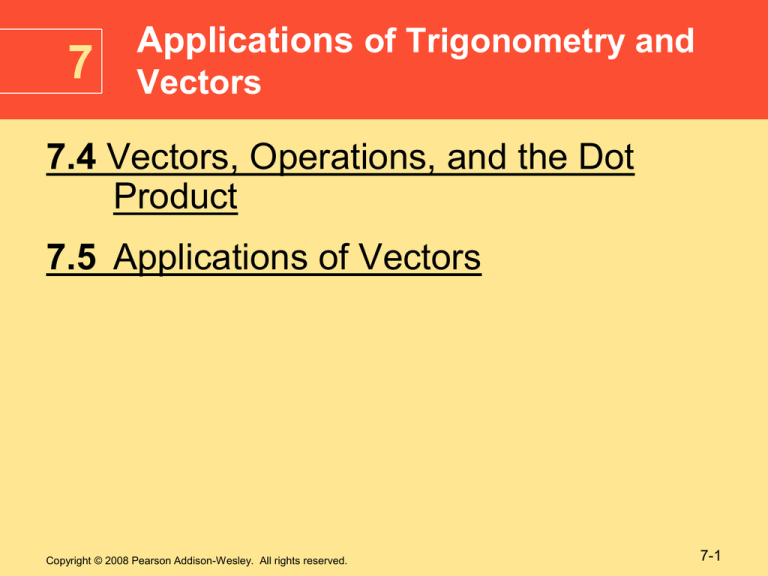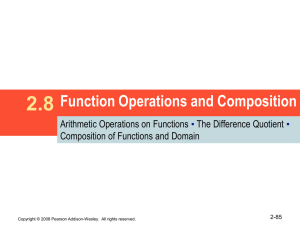
7
Applications of Trigonometry and
Vectors
7.4 Vectors, Operations, and the Dot
Product
7.5 Applications of Vectors
Copyright © 2008 Pearson Addison-Wesley. All rights reserved.
7-1
7.4
Vectors, Operations, and the
Dot Product
Basic Terminology ▪ Algebraic Interpretation of Vectors ▪
Operations with Vectors ▪ Dot Product and the Angle Between
Vectors
Copyright © 2008 Pearson Addison-Wesley. All rights reserved.
7-2
7.4 Example 1 Finding Magnitude and Direction Angle
Find the magnitude and direction angle for
Magnitude:
Direction angle:
Copyright © 2008 Pearson Addison-Wesley. All rights reserved.
7-3
7.4 Example 2 Finding Horizontal and Vertical Components
Vector v has magnitude 14.5 and direction angle
220°. Find the horizontal and vertical components.
Horizontal component: –11.1
Vertical component: –9.3
Copyright © 2008 Pearson Addison-Wesley. All rights reserved.
7-4
7.4
Example 3 Writing Vectors in the Form a, b
Write each vector in the form a, b.
u: magnitude 8, direction angle 135°
v: magnitude 4, direction angle 270°
w: magnitude 10, direction angle 340°
Copyright © 2008 Pearson Addison-Wesley. All rights reserved.
7-5
7.4
Example 4 Finding the Magnitude of a
Resultant
Two forces of 32 and 48 newtons act on a point in the
plane. If the angle between the forces is 76°, find the
magnitude of the resultant vector.
because the
adjacent angles of a
parallelogram are supplementary.
Law of cosines
Find square
root.
Copyright © 2008 Pearson Addison-Wesley. All rights reserved.
7-6
7.4
Example 6 Finding Dot Products
Find each dot product.
Copyright © 2008 Pearson Addison-Wesley. All rights reserved.
7-7
7.4 Example 7 Finding the Angle Between Two Vectors
Find the angle θ between the two vectors u = 5, –12
and v = 4, 3.
Copyright © 2008 Pearson Addison-Wesley. All rights reserved.
7-8
7.5
Applications of Vectors
The Equilibrant ▪ Incline Applications ▪ Navigation Applications
Copyright © 2008 Pearson Addison-Wesley. All rights reserved.
7-9
7.5
Example 2 Finding a Required Force
Find the force required to keep a 2500-lb car parked
on a hill that makes a 12° angle with the horizontal.
The vertical force BA represents the force of gravity.
BA = BC + (–AC)
Copyright © 2008 Pearson Addison-Wesley. All rights reserved.
7-10
7.5
Example 2 Finding a Required Force (cont.)
Vector BC represents the
force with which the
weight pushes against
the hill.
Vector BF represents the force that
would pull the car up the hill.
Since vectors BF and AC are equal,
magnitude of the required force.
Copyright © 2008 Pearson Addison-Wesley. All rights reserved.
gives the
7-11
7.5
Example 2 Finding a Required Force (cont.)
Vectors BF and AC are
parallel, so the measure
of angle EBD equals the
measure of angle A.
Since angle BDE and angle C are
right angles, triangles CBA and DEB
have two corresponding angles that
are equal and, thus, are similar
triangles.
Therefore, the measure of angle ABC equals the
measure of angle E, which is 12°.
Copyright © 2008 Pearson Addison-Wesley. All rights reserved.
7-12
7.5
Example 2 Finding a Required Force (cont.)
From right triangle ABC,
A force of approximately 520 lb will keep the car
parked on the hill.
Copyright © 2008 Pearson Addison-Wesley. All rights reserved.
7-13
7.5
Example 3 Finding an Incline Angle
A force of 18.0 lb is required to hold a 74.0-lb crate on
a ramp. What angle does the ramp make with the
horizontal?
Vector BF represents the
force required to hold the
crate on the incline.
In right triangle ABC, the measure of angle B equals
θ, the magnitude of vector BA represents the weight
of the crate, and vector AC equals vector BF.
Copyright © 2008 Pearson Addison-Wesley. All rights reserved.
7-14
7.5
Example 3 Finding an Incline Angle (cont.)
The ramp makes an angle of about 14.1° with the
horizontal.
Copyright © 2008 Pearson Addison-Wesley. All rights reserved.
7-15
7.5
Example 4 Applying Vectors to a Navigation
Problem
A ship leaves port on a bearing of 25.0° and travels
61.4 km. The ship then turns due east and travels
84.6 km. How far is the ship from port? What is its
bearing from port?
Vectors PA and AE represent the ship’s path. We are
seeking the magnitude and bearing of PE.
Copyright © 2008 Pearson Addison-Wesley. All rights reserved.
7-16
7.5
Example 4 Applying Vectors to a Navigation
Problem
(cont.)
Triangle PNA is a right
triangle, so the measure of
angle NAP = 90° − 25.0°
= 65.0°.
The measure of angle PAE = 180° − 65.0 = 115.0°.
Law of cosines
The ship is about 123.8 km from port.
Copyright © 2008 Pearson Addison-Wesley. All rights reserved.
7-17
7.5
Example 4 Applying Vectors to a Navigation
Problem
(cont.)
To find the bearing of the
ship from port, first find the
measure of angle APE.
Law of sines
Now add 38.3° to 25.0° to find that the bearing is
63.3°.
Copyright © 2008 Pearson Addison-Wesley. All rights reserved.
7-18
7.5
Example 5 Applying Vectors to a Navigation
Problem
A plane with an airspeed of 355 mph is headed on a
bearing of 62°. A west wind is blowing (from west to
east) at 28.5 mph. Find the groundspeed and the
actual bearing of the plane.
The groundspeed is represented by |x|.
Copyright © 2008 Pearson Addison-Wesley. All rights reserved.
7-19
7.5
Example 5 Applying Vectors to a Navigation
Problem
(cont.)
Law of cosines
The plane’s groundspeed is about 380 mph.
Copyright © 2008 Pearson Addison-Wesley. All rights reserved.
7-20
7.5
Example 5 Applying Vectors to a Navigation
Problem
(cont.)
Use the law of sines to find
α, and then determine the
bearing, 62° + α.
The bearing is about 62° + 2° = 64°.
Copyright © 2008 Pearson Addison-Wesley. All rights reserved.
7-21
8
Complex Numbers, Polar Equations, and
Parametric Equations
8.5 (part I) Polar Coordinates
8.1 Complex Numbers
8.2 Trigonometric (Polar) Form of Complex
Numbers
8.3 The Product and Quotient Theorems
8.4 De Moivre’s Theorem; Powers and Roots of
Complex Numbers
8.5 (part II) Polar Equations and Graphs
Copyright © 2008 Pearson Addison-Wesley. All rights reserved.
8-22
8.5 Polar Coordinates (part I)
Polar Coordinate System ▪ Converting Polar and Rectangular
Coordinates
Copyright © 2008 Pearson Addison-Wesley. All rights reserved.
8-23
8.5 Example 1 Plotting Points With Polar Coordinates
Plot each point by hand in the polar coordinate
system. Then, determine the rectangular coordinates
of each point.
The rectangular coordinates
of P(4, 135°) are
Copyright © 2008 Pearson Addison-Wesley. All rights reserved.
8-24
8.5
Example 1 Plotting Points With Polar
Coordinates (cont.)
The rectangular coordinates of
Copyright © 2008 Pearson Addison-Wesley. All rights reserved.
8-25
8.5
Example 1 Plotting Points With Polar
Coordinates (cont.)
The rectangular coordinates of
Copyright © 2008 Pearson Addison-Wesley. All rights reserved.
are (0, –2).
8-26
8.5
Example 2(a) Giving Alternative Forms for
Coordinates of a Point
Give three other pairs of polar coordinates for the
point P(5, –110°).
Three pairs of polar coordinates for the point
P(5, −110º) are (5, 250º), (−5, 70º), and (−5, −290º).
Other answers are possible.
Copyright © 2008 Pearson Addison-Wesley. All rights reserved.
8-27
8.5
Example 2(b) Giving Alternative Forms for
Coordinates of a Point
Give two pairs of polar coordinates for the point with
the rectangular coordinates
The point
Since
300°.
lies in quadrant II.
, one possible value for θ is
Two pairs of polar coordinates are (12, 300°) and
(−12, 120°).
Other answers are possible.
Copyright © 2008 Pearson Addison-Wesley. All rights reserved.
8-28
8.1
Complex Numbers
Basic Concepts of Complex Numbers ▪ Complex Solutions of
Equations ▪ Operations on Complex Numbers
Copyright © 2008 Pearson Addison-Wesley. All rights reserved.
8-29
8.1
Example 1 Writing √–a as i√a
Write as the product of real number and i, using the
definition of
Copyright © 2008 Pearson Addison-Wesley. All rights reserved.
8-30
8.1
Example 2 Solving Quadratic Equations for Complex
Solutions
Solve each equation.
Copyright © 2008 Pearson Addison-Wesley. All rights reserved.
8-31
8.1
Example 3 Solving a Quadratic Equation for Complex
Solutions
Write the equation in standard form,
then solve using the quadratic formula with a = 2,
b = –2, and c = 5.
Copyright © 2008 Pearson Addison-Wesley. All rights reserved.
8-32
8.1
Example 4 Finding Products and Quotients Involving
Negative Radicands
Multiply or divide as indicated. Simplify each answer.
Copyright © 2008 Pearson Addison-Wesley. All rights reserved.
8-33
8.1
Example 5 Simplifying a Quotient Involving a Negative
Radicand
Write
in standard form.
Copyright © 2008 Pearson Addison-Wesley. All rights reserved.
8-34
8.1 Example
6 Adding and Subtracting Complex Numbers
Find each sum or difference.
(a) (4 – 5i) + (–5 + 8i) = [4 + (–5)] + (–5i + 8i)
= –1 + 3i
(b) (–6 + 3i) + (12 – 9i) = 6 – 6i
(c) (–10 + 7i) – (5 – 3i) = (–10 – 5) + [7i + (3i)]
= –15 + 10i
(d) (15 – 8i) – (–10 + 4i) + (–25 + 12i)
= [15 – (–10) + (–25)] + [–8i – 4i + 12i]
= 0 + 0i
Copyright © 2008 Pearson Addison-Wesley. All rights reserved.
8-35
8.1
Example 7 Multiplying Complex Numbers
Find each product.
(a) (5 + 3i)(2 – 7i) = 5(2) + (5)(–7i) + (3i)(2) + (3i)(–7i)
= 10 – 35i + 6i – 21i2
= 10 – 29i – 21(–1)
= 31 – 29i
(b) (4 – 5i)2 = 42 – 2(4)(5i) + (5i)2
= 16 – 40i + 25i2
= 16 – 40i + 25(–1)
= –9 – 40i
Copyright © 2008 Pearson Addison-Wesley. All rights reserved.
8-36
8.1
Example 7 Multiplying Complex Numbers (cont.)
(c) (3 – i)(–3 + i)
= –9 + 3i + 3i – i2
= –9 + 6i – (–1)
= –9 + 6i + 1
= –8 + 6i
(d) (9 – 8i)(9 + 8i) = 92 – (8i)2
= 81 – 64i2
= 81 – 64(–1)
= 81 + 64
= 145 or 145 + 0i
Copyright © 2008 Pearson Addison-Wesley. All rights reserved.
8-37
8.1
Example 8 Simplifying Powers of i
Simplify each power of i.
(a)
(b)
Write the given power as a product involving
or
.
(a)
Copyright © 2008 Pearson Addison-Wesley. All rights reserved.
(b)
8-38
8.1
Example 8 Simplifying Powers of i (cont.)
(c)
Copyright © 2008 Pearson Addison-Wesley. All rights reserved.
8-39
8.1
Example 9(a) Dividing Complex Numbers
Write the quotient in standard form a + bi.
Multiply the numerator and
denominator by the complex
conjugate of the denominator.
Multiply.
i2 = –1
Combine terms.
Lowest terms; standard form
Copyright © 2008 Pearson Addison-Wesley. All rights reserved.
8-40
8.1
Example 9(b) Dividing Complex Numbers
Write the quotient in standard form a + bi.
Multiply the numerator and
denominator by the complex
conjugate of the denominator.
Multiply.
–i2 = 1
Lowest terms; standard form
Copyright © 2008 Pearson Addison-Wesley. All rights reserved.
8-41
8.2
Trigonometric (Polar) Form of Complex
Numbers
The Complex Plane and Vector Representation ▪ Trigonometric
(Polar) Form ▪ Converting Between Rectangular and
Trigonometric (Polar) Forms ▪ An Application of Complex
Numbers to Fractals
Copyright © 2008 Pearson Addison-Wesley. All rights reserved.
8-42
8.2
Example 1 Expressing the Sum of Complex Numbers
Graphically
Find the sum of 2 + 3i and –4 + 2i. Graph both
complex numbers and their resultant.
(2 + 3i) + (–4 + 2i) = –2 + 5i
Copyright © 2008 Pearson Addison-Wesley. All rights reserved.
8-43
8.2
Example 2 Converting From Trigonometric Form to
Rectangular Form
Express 10(cos 135° + i sin 135°) in rectangular form.
Copyright © 2008 Pearson Addison-Wesley. All rights reserved.
8-44
8.2
Example 3(a) Converting From Rectangular Form to
Trigonometric Form
Write 8 – 8i in trigonometric form.
The reference angle for θ is 45°.
The graph shows that θ is in
quadrant IV, so θ = 315°.
Copyright © 2008 Pearson Addison-Wesley. All rights reserved.
8-45
8.2
Example 3(b) Converting From Rectangular Form to
Trigonometric Form
Write –15 in trigonometric form.
–15 = –15 + 0i
–15 + 0i is on the negative
x-axis, so θ = 180°.
Copyright © 2008 Pearson Addison-Wesley. All rights reserved.
8-46
8.2
Example 4 Converting Between Trigonometric and
Rectangular Forms Using Calculator
Approximations
Write each complex number in its alternative form,
using calculator approximations as necessary.
(a) 7(cos 205° + i sin 205°) ≈ –6.3442 – 2.9583i
Copyright © 2008 Pearson Addison-Wesley. All rights reserved.
8-47
8.2
Example 4 Converting Between Trigonometric and
Rectangular Forms Using Calculator
Approximations (cont.)
(b) –7 + 2i
x = −7 and y = 2
The reference angle for θ is approximately 15.95°.
The graph shows that θ is in quadrant II, so
θ = 180° – 15.95° = 164.05°.
Copyright © 2008 Pearson Addison-Wesley. All rights reserved.
8-48
8.3
The Product and Quotient Theorems
Products of Complex Numbers in Trigonometric Form ▪
Quotients of Complex Numbers in Trigonometric Form
Copyright © 2008 Pearson Addison-Wesley. All rights reserved.
8-49
8.3
Product Theorem
r1 (cos 1 i sin 1 ) r2 (cos 2 i sin 2 )
Can be written as
r1r2 [cos(1 2 ) i sin(1 2 )]
Copyright © 2008 Pearson Addison-Wesley. All rights reserved.
8-50
8.3
Example 1 Using the Product Theorem
Find the product of 4(cos 120° + i sin 120°) and
5(cos 30° + i sin 30°). Write the result in rectangular
form.
Copyright © 2008 Pearson Addison-Wesley. All rights reserved.
8-51
8.3
Quotient Theorem
r1 (cos 1 i sin 1 )
r2 (cos 2 i sin 2 )
Can be written as
r1
[cos(1 2 ) i sin(1 2 )]
r2
Copyright © 2008 Pearson Addison-Wesley. All rights reserved.
8-52
8.3
Example 2 Using the Quotient Theorem
Find the quotient
rectangular form.
Copyright © 2008 Pearson Addison-Wesley. All rights reserved.
Write the result in
8-53
8.3
Example 3 Using the Product and Quotient Theorems
With a Calculator
Use a calculator to find the following. Write the results
in rectangular form.
Copyright © 2008 Pearson Addison-Wesley. All rights reserved.
8-54
8.3
Example 3 Using the Product and Quotient Theorems
With a Calculator (cont.)
Copyright © 2008 Pearson Addison-Wesley. All rights reserved.
8-55
8.4
De Moivre’s Theorem; Powers and
Roots of Complex Numbers
Powers of Complex Numbers (De Moivre’s Theorem) ▪ Roots of
Complex Numbers
Copyright © 2008 Pearson Addison-Wesley. All rights reserved.
8-56
8.4
Example 1 Finding a Power of a Complex Number
Find
form.
First write
and express the result in rectangular
in trigonometric form.
and
Because x and y are both positive, θ is in quadrant I,
so θ = 45°.
Copyright © 2008 Pearson Addison-Wesley. All rights reserved.
8-57
8.4
Example 1 Finding a Power of a Complex Number
(cont.)
Copyright © 2008 Pearson Addison-Wesley. All rights reserved.
8-58
8.4
Example 2 Finding Complex Roots
Find the three cube roots of 8 (cos 180o + i sin 180o).
Write the roots in rectangular form.
Note that [2 (cos 60o + i sin 60o)]3 = 8 (cos 180o + i sin 180o).
So one cube root is 2 (cos 60o + i sin 60o)
The other 2 are
360
120 apart
3
2 (cos 180o + i sin 180o) and 2 (cos 300o + i sin 300o)
If cubed all 3 will yield 8 in rectangular form
Copyright © 2008 Pearson Addison-Wesley. All rights reserved.
8-59
8.4
Example 3 Finding Complex Roots
Find all fourth roots of
Write the roots in rectangular form.
First write
in trigonometric form.
Because x and y are both negative, θ is in quadrant
III, so θ = 240°.
Copyright © 2008 Pearson Addison-Wesley. All rights reserved.
8-60
8.4
Example 3 Finding Complex Roots
Copyright © 2008 Pearson Addison-Wesley. All rights reserved.
(cont.)
8-61
8.5 Polar Equations and Graphs (part II)
Graphs of Polar Equations ▪ Converting from Polar to
Rectangular Equations ▪ Classifying Polar Equations
Copyright © 2008 Pearson Addison-Wesley. All rights reserved.
8-62
8.5
Example 3 Examining Polar and Rectangular Equations
of Lines and Circles
For each rectangular equation, give the equivalent
polar equation and sketch its graph.
(a) y = 2x – 4
In standard form, the equation is 2x – y = 4, so a = 2,
b = –1, and c = 4.
The general form for the polar equation of a line is
y = 2x – 4 is equivalent to
Copyright © 2008 Pearson Addison-Wesley. All rights reserved.
8-63
8.5
Example 3 Examining Polar and Rectangular Equations
of Lines and Circles (cont.)
Copyright © 2008 Pearson Addison-Wesley. All rights reserved.
8-64
8.5
Example 3 Examining Polar and Rectangular Equations
of Lines and Circles (cont.)
This is the graph of a circle with center at the origin
and radius 5.
Note that in polar coordinates it is possible for r < 0.
Copyright © 2008 Pearson Addison-Wesley. All rights reserved.
8-65
8.5
Example 3 Examining Polar and Rectangular Equations
of Lines and Circles (cont.)
Copyright © 2008 Pearson Addison-Wesley. All rights reserved.
8-66
8.5
Example 8 Converting a Polar Equation to a Rectangular
Equation
#53
r 2sin( )
#58
2
r
4 cos sin
#60
r 5csc( )
Copyright © 2008 Pearson Addison-Wesley. All rights reserved.
8-67
8.5
Example 4 Graphing a Polar Equation (Cardioid)
Find some ordered pairs to determine a pattern of
values of r.
Copyright © 2008 Pearson Addison-Wesley. All rights reserved.
8-68
8.5
Example 4 Graphing a Polar Equation (Cardioid) (cont.)
Connect the points in order from (1, 0°) to (.5, 30°) to
(.1, 60°) and so on.
Copyright © 2008 Pearson Addison-Wesley. All rights reserved.
8-69
8.5
Example 5 Graphing a Polar Equation (Rose)
Find some ordered pairs to determine a pattern of
values of r.
Copyright © 2008 Pearson Addison-Wesley. All rights reserved.
8-70
8.5
Example 5 Graphing a Polar Equation (Rose) (cont.)
Connect the points in order from (4, 0°) to (3.6, 10°)
to (2.0, 20°) and so on.
Copyright © 2008 Pearson Addison-Wesley. All rights reserved.
8-71
8.5
Example 7 Graphing a Polar Equation (Spiral of
Archimedes)
Graph r = –θ (θ measured in radians).
Go to wzgrapher. Use domain [0, 20π]
Copyright © 2008 Pearson Addison-Wesley. All rights reserved.
8-72







